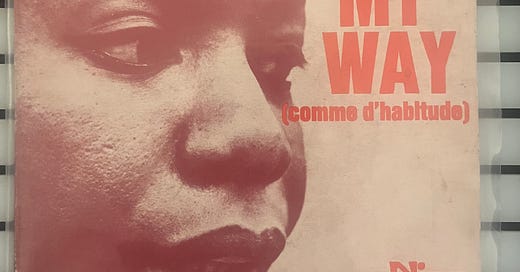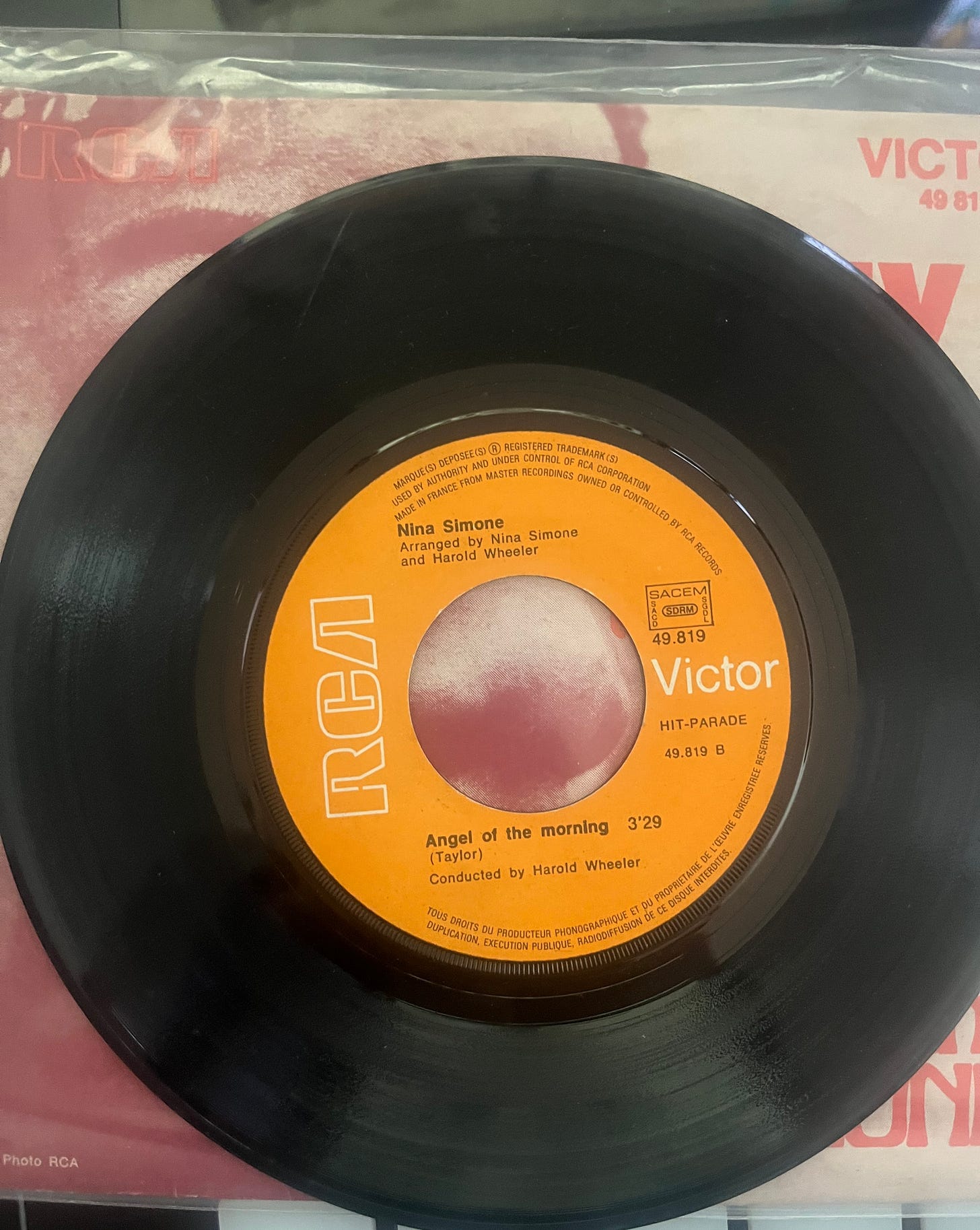Out of the Box is an irregular series focusing on seven inch records. It’s an excuse to engage with my collection in a new way, as well as to write about older records and genres we don’t often cover at ACL.
OUT OF THE BOX #18
Nina Simone ~ My Way (comme d'habitude) (1971)
Recent installments in this series have been squarely within ACL’s remit, so to move a bit closer to the older records and genres aspect of OUT OF THE BOX, this month I’ve chosen a Nina Simone single. I picked this up, I believe, at La Dame Blanche Record Shop in Paris back in 2015 along with some Avant-Garde series LPs (Cage, Nono), a Varèse LP, and a bunch of other seven inches. And of course this is an interesting one in so far as Simone is doing a version of the song that became Sinatra’s signature, while also referencing the original French version.
First, a bit about my personal relationship with the music of Miss Nina Simone. In the summer of 2000, at the age of 16, I started working at Starbucks, first in the nearby affluent suburb of Rye, NY and later at the Cooper Union Starbucks on the corner of Third Avenue and St. Mark’s Place in NYC. Back then we had digital cassette tapes with hours of music on them which we were required to play, a system which was later updated to a solid state machine (though some of us punk employees did, for example, connect our ipods to the store’s sound system when we could). I actually received quite a musical education from those early Starbucks soundtracks, I’ll admit it. There were whole genres of music I became acquainted with over many shifts. A Starbucks compilation from 2000 included Nina Simone’s “I Put A Spell On You,” and I was instantly drawn to her voice, its power and, perhaps, androgyny. I’d probably already encountered songs like “Spell” or “My Baby Just Cares for Me” (1959) but it was hearing her voice at Starbucks that piqued my interest. She certainly didn’t sound like anyone else, and I was appropriately enchanted by that song.
And then, in November 2002, Talib Kweli released Quality, with the single “Get By,” produced by a then-little-known producer named Kanye West (whose debut solo album, The College Dropout would be released in February 2004). That song prominently features samples from Nina Simone’s “Sinnerman” (1962), a masterpiece that clocks in at over 10 minutes, a lesson in tension and release and structure and emotional delivery. That song comes after “Strange Fruit,” the final song on her 1965 LP, Pastel Blues, because of course it does; what could follow this?
I instantly loved how Kanye flipped the sample, even if I love the original more. But it was a few more years until I really began to dig into Simone’s catalog and read more about her life story. The impetus for that was a line from Thee Silver Mt. Zion Memorial Orchestra’s “God Bless Our Dead Marines” from 2005’s Horses in the Sky, when they ask, “who among us will avenge miss Nina Simone?”
Speaking of songs that resonate with me more strongly over the years, “Dead Marines” has become something of my anthem of these times. (But that’s an essay for another time.) Mt. Zion’s invocation of Simone triggered a process of discovery for me, as I delved deeper into Simone’s life and work. Her “Mississippi Goddam” examplifies her commitment to social and political struggle, her willingness and perhaps need to resist, to confront, to speak truth to power.
And indeed that confrontational energy cost her; the record industry punished her for “Goddam,” leading to her being blacklisted and her records boycotted. She left the States in the late 1960s, living and Barbados and Liberia before eventually settling in France (as so many African-Americans had done throughout the 20th century, for instance Josephine Baker, Richard Wright, James Baldwin, Eartha Kitt, and The Art Ensemble of Chicago). Beyond her highly original compositions, she was also famous for her transformative versions of other’s tunes, including Abel Meerepol and Billie Holiday’s “Strange Fruit,” or the folk song “House of the Rising Sun” (of which there is a Joan Baez version from 1960, an arrangement by Dave Van Ronk from 1961, Simone first recorded in 1962, and that The Animals would make famous in 1964).
So now let’s turn to Simone’s “My Way.” This seven inch was released in France by the RCA Victor label’s Hit Parade imprint in 1971. Sinatra’s version recorded in 1968 and released in 1969, so Simone’s version was just a few years afterwards, and would also be included in her 1972 compilation LP, My Way, also released in France by Victor and included multiple other cover songs, including by Pete Seeger and George Harrison. Both Simone and Sinatra’s versions were based on the French-language original, a chanson called “Comme d’habitude” [as usual], written in 1967 by Jacques Revaux, with lyrics by Claude François (who also performed the song) and Gilles Thibaut, and which would later be covered by many other French artists.
The text of “Comme d’habitude” speaks of a couple whose relationship has become strained and fallen into predicable patterns, heralding a difficult breakup. While the tune builds to a dramatic climax, much of the song echoes the repetition of “comme d’habitude,” or the habits we become trapped within, and much of the song feels somewhat plodding and monotonous (not unlike said relationship). But this differentiates the song quite strongly from its later English versions as “My Way.”
Still, it’s not quite right to think of “My Way” as an English version of “Comme d’habitude”; the English text was written by Paul Anka. [According to VH1’s Storyellers, in 1968 David Bowie, then working as a songwriter for-hire, was commissioned to work on an English version, which was demoed but never formally recorded nor released, though which he later developed into a wholly new song, “Life on Mars?” Anka’s text is not a translation of the French lyrics but a new song, one which Sinatra' transformed into a personal anthem. Frank’s version also speaks of an ending, but not of a relationship: “… And now, the end is near”; “… Regrets, I've had a few”; “… For what is a man, what has he got?” Whereas the subject of “Comme d’habitude” is at the mercy of the fates, awaiting the inevitable end of a relationship, Ol’ Blue Eyes sings an ode to his own agency. Sinatra asks existential questions of a different nature, looking back at one’s life, and passing judgment in total. That judgment? Defiant and affirmative: “I did it my way.”
Halfway through the song Sinatra reaches his first crescendo, before lowering the tenor and slowly ramping back up for the final climax. It is this dynamism that makes the song so powerful, and also a song so commonly butchered at karaoke as singers go too big too fast. (Cf. “The My Way killings.”) Restraint is key. Sinatra and Simone were mutual admirers, and shared a small batch of songs both recorded, also including “Ne Me Quitte Pas” and “Love's Been Good to Me.” Sinatra previously recorded a version of Simone’s signature song, “My Baby Just Cares for Me,” for his 1996 LP Strangers in the Night, so it makes sense that she would have a version of the song that would become his.
Simone’s version of “My Way” begins more insistently (“We Insist!”), with a faster tempo and furious hand drumming giving a somewhat Latin inflection to the arrangement, which is certainly the most spritely of the three. While Sinatra seems to take charge in a stereotypically masculine American way, the French narrator submits to the woman in his life, again, resounding himself to fate (and the end of their relationship). Simone’s narrator is no less assertive, but where Sinatra might read as American chauvinism, Simone’s version further subverts the script. Simone’s “My Way” is a refusal to submit, its defiance more obstinate and unyielding. And yet the melodic flourishes of the electric piano help keep the song buoyant and light. Each verse ends with an insistent staccato flourishes, underscoring the end of the verse and clearly ushering in the following, each of which adds additional musical elements: harp, harpsichord and piano are joined by electric bass, strings, and more. Where Sinatra addresses “My Friend,” and did it all “not in a shy way,” Simone subtley changes the significance, pluralizing “friends” and changing shy to sly. Simone’s version is also about an end, but for her it is a triumphant escape into freedom, not the tragic end of a romance or self-aggrandizement.
A final bit of trivia: the Serbian performance artist Marina Abramović has allegedly requested that Anohni sing Simone’s version of “My Way” at her funeral. (I’d like to hear that.)
The B-side, is “Angel of the morning,” which would later lend its title to a 2009 Best of Nina Simone album. This tune was also written in 1967, by American singer and songwriter Chip Taylor (uncle of Angelina Jolie), popular versions of which have been recorded by Merrilee Rush (1968), Dusty Springfield ( 1969), and The Pretenders (1994), among many others. For my fellow geriatric millennials, we must also mention Shaggy’s 2001 hit single, “Angel,” which featured Barbadian singer Rayvon interpolating the melody of “Angel of the morning” as the song’s hook. Simone’s version begins with the harp, and is delivered at a slower tempo with lush arrangements. Simone’s piano also features more prominently here, though the string and vocal arrangements, augmented by another electric piano doubling the melody in the chorus. I find the backing vocals to sit oddly, but perhaps that contrast between the lead and the backing was the intended affect. A lovely ballad to counter the energy of the A-side, but not much else here grabbing my attention at this time.





A fascinating deep dive. Thank you.